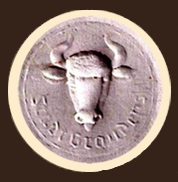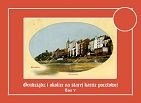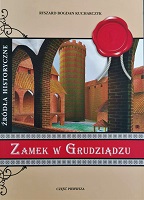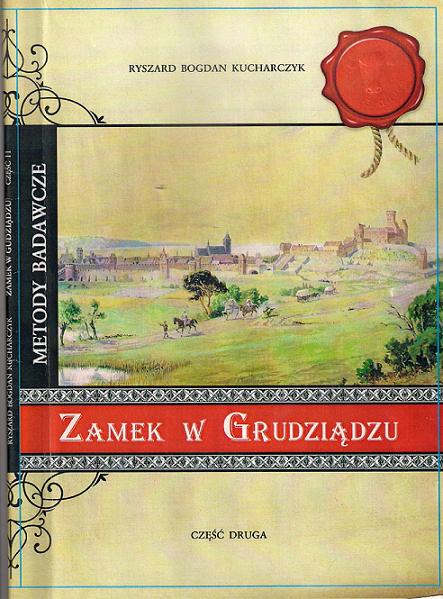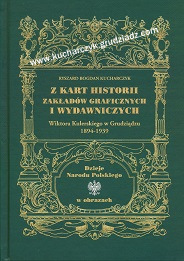Main page / Volume V



POLISH / ENGLISH / GERMAN
Grudziądz and its surroundings in old postcards
The album that you are holding in your hands is the fifth, and at the same time the last volume in the series „Grudziądz and its surroundings in old postcards”. The popular series of charming albums has surpassed all the expectations. It turned out that the interest in the topic, especially among students is high. All schools in Grudziądz and the vicinity have acquired the whole series for their library collections. Such eager interest led to the reissuing of volume 1 and soon later, of volume 2. I am glad that the inhabitants of Grudziądz are not indifferent to the subject of pre-war image of the city.
In volume 1 one I mentioned that it is Heinrich von Stephan (born 07 January 1831 in Słupsk, died 08 May 1897 in Berlin) who is believed to have discovered postcards as a form of correspondence. On the last page of the album I have placed a card issued in 1931 on the occasion of 100th anniversary of the discoverer's birth and introduced into circulation.
Moreover, more colourful editions of lithographic cards cycle have found their way into the album. There is one remarkable card, which is repeatedly sought for by philocartists, showing a horse tramway in what today is Wybickiego Street. Further in the album there is a view of a tram station with a horse tramcar and the crew in today's Dworcowa Street. Also, I would like to attract your attention to an interesting card of 1911, sent from Grudziądz and showing the castle of Grudziądz, probably seen in the eye an unknown painter.
My passion also translates into active participation in the Grassroots Committee of Klimek Tower Reconstruction. My intention is to donate the profit from the sales of the last volume towards the reconstruction of the tower and the ruins of the castle. It will be the contribution of our local community to the reconstruction of the monument. Adding more attractiveness to the whole Castle Hill will bring back its past splendour and will make it more pleasant to relax at for the inhabitants of Grudziądz and visitors to the city.
I would like to express my gratitude to the media patrons including Wiktor Kulerski Library in Grudziądz
Ryszard Bogdan Kucharczyk
 This beautiful modernist multi-storey villa with harmonious proportions was built at the beginning of 20th century. The building of an area of 899 sq m is an example of classicist baroque. From the facade it is surrounded by a stylish openwork fence with balusters and beautiful square. The elevation was constructed in neo-Renaissance style with rustic corners and a base course, and finished with a high tile mansard roof. In the central part of the facade a slightly protruding break with and elegant portal and fan stairs can be seen. Inside the building a modern central heating system was installed and openwork ceilings were applied in the storerooms of the library. When taken as a whole, it creates a friendly and cosy interior, which arouses trust and indicates a good architect.
This beautiful modernist multi-storey villa with harmonious proportions was built at the beginning of 20th century. The building of an area of 899 sq m is an example of classicist baroque. From the facade it is surrounded by a stylish openwork fence with balusters and beautiful square. The elevation was constructed in neo-Renaissance style with rustic corners and a base course, and finished with a high tile mansard roof. In the central part of the facade a slightly protruding break with and elegant portal and fan stairs can be seen. Inside the building a modern central heating system was installed and openwork ceilings were applied in the storerooms of the library. When taken as a whole, it creates a friendly and cosy interior, which arouses trust and indicates a good architect.
This well-known building of Grudziądz will soon be celebrating 100th anniversary but the history of its creation goes back as far as to the end of 19th century.
On 24th November 1883, by the initiative of Siegfrid Anger, the head of King's Grammar School (Gimnazjum Królewskie) the Association of Antiquity was established in Grudziądz, which on 15th June 1884 set up the City Museum of Antiquities located at the Abbesses' Palace. After a fire of the City Hall in 1893 the museum was forced to leave its seat to the city's authorities, and for a short time the collection was moved to the King's Grammar School. From 1899 a baroque refectory of the Jesuit college becomes the new seat of museum. However, due to a steady increase of the library collection, it was necessary to find new premises.
The project of setting up a real institution was again supervised by the chairman of the Association, Dr Siegfrid Anger. He held talks with Grudziądz local authorities, provincial authorities in Gdańsk and ministerial ones in Berlin. Finally, the municipality allotted a plot at 28 Lipowa Street for the construction of a library and a museum. The first design of the building was presented on 27th April 1904 but it was a later design that was completed, with an estimate cost of the construction reaching ca. 120 thousand marks.
Unfortunately, no information on the architect's name was recorded anywhere. It is assumed that he was a representative of the Berlin community. It is known, however, who financed the construction of the building. The funds for the purpose were provided by the City Council of Grudziądz and central authorities from Berlin, and the remaining part was obtained from a legacy made by Gustaw Roethe's, who died in Berlin in 1901. He was the owner of a local printing house and a publisher of a newspaper „Der Gesellige”. He was also a co founder and a honorary member of the Association of Antiquities. He bequeathed to the city a sum of 60 thousand marks which he allowed for the construction of a library and building of the museum (25 thousand marks), the purchase of the library (15 thousand) and the development of the library and museum collections (20 thousand). Finally between 1908 and 1911 the construction of the beautiful building was completed. Apart from the German Association of Antiquities, three other institutions were seated there in 1912 a German library, a museum and the city archive. A collection of 200 old prints has remained from those times.
In 1921 soon after independence was regained, a Polish library was established in the building by the Society of Popular Reading Rooms (Towarzystwo Czytelni Ludowych). A year later the facility gave shelter to yet another two cultural institutions: between 1922 and 1933 the famous Pomeranian School of Fine Arts run by Prof. Wacław Szczeblewski and Polish Tourist Society (Polskie Towarzystwo Krajoznawcze) managed by Rev. Dr Władysław Łęga.
In 1939 the Germans entered Grudziądz and began the occupation of the city by totally destroying all sign of Polish identity. Among others, they burnt down the whole Polish library which amounted to 35,000 volumes and all annual bound volumes of the „Gazeta Grudziądzka”. The museum collection as well as the archive documents were taken out and the building itself during the war became a seat of a German library, a museum and a German archive.
After 1945, during hard combats to liberate Grudziądz, nearly the whole city was totally destroyed. The library building was among few surviving monuments, so as soon as one and a half months after military activities ended, it was possible to begin construction of a public library. A ceremonial opening of the City Public Library in Grudziądz took place on 20th May 1946 and since then up to now it has been seated in this beautiful building.
Aleksandra Ciżnicka
Tom V
Click on miniature, to increase photo. Click " zamknij ", go out .
